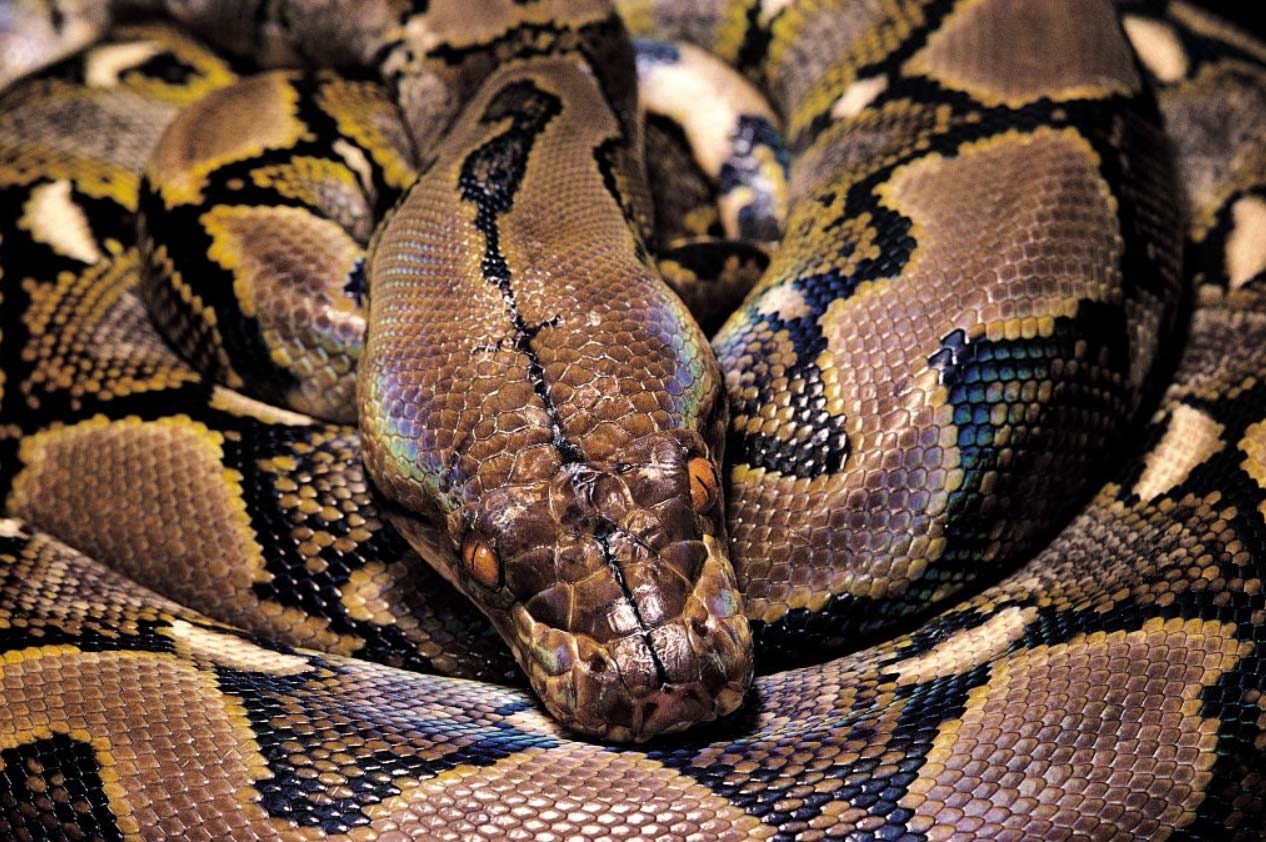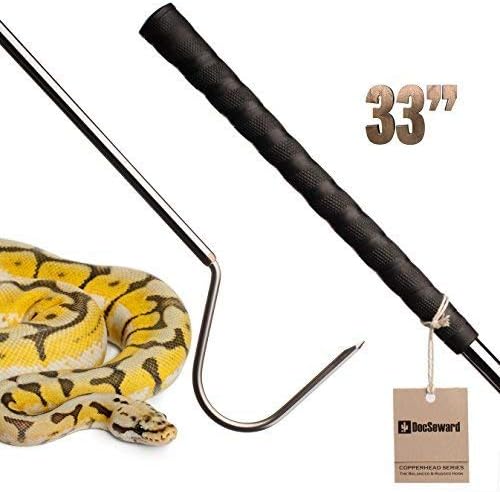World’s longest snake.
The Reticulated Python (Python reticulatus) is the world’s longest snake with the largest reaching over 30 feet! The sheer size of the snake is why it is on our Expert Level even though most of its care is very similar to other python species.
Captive-bred specimens are actively disproving the old mentality that Retics are aggressive animals that make bad pets.
Wild-caught specimens display their natural behavior, which is understandably aggressive coming from the wild, due to the stress of capture and unknown environments. Captive-bred specimens make good pets to the owners who can provide for them.
| Common Name: | Reticulated Python, Retic |
| Scientific Name: | Python reticulatus |
| Natural Habitat: | Southeast Asia, Philippines, Thailand, Eastern Sudan, Queensland, and Northern Territory in Australia |
| Adult Size: | Average at 20 feet in captivity |
| Lifespan: | Average at 30 years |
| Diet: | Mammals, birds, reptiles |
| Experience Level: | Advanced intermediate to Expert |
| Enclosure Size: | Minimum the length of your snake for length X half your snake’s length for height and depth |
Reptile Overview
Reticulated Pythons are the world’s longest snake beating out the Green Anaconda in length but not weight.
They are aggressive if they come from the wild. Their natural prey instinct and attack response are honed to survival in the wild so this is understandable.
When they are captive-bred and raised with appropriate socialization, Retics make great pets both for viewing and handling pleasure.
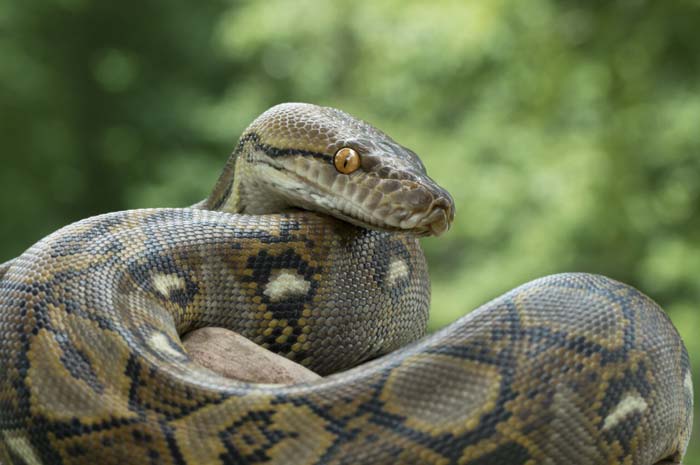
These snakes are listed as Least Concern by CITES, however, their capture and trade are heavily monitored to avoid a decline in the natural population.
The wild snakes are caught for the skin trade and pet trade, they are also caught for the illegal pet trade.
Interesting fact: Native tribes (and other enterprising locals) hunt the snakes for their vast quantities of meat!
We suggest purchasing your Retic from a reputable breeder that can give you information on the parental morph genetics so you know exactly what kind of animal you are dealing with.
Appearance
The average length of the Reticulated Python is about 20 feet in captivity on an average diet for an owner who is not breeding for size. They weigh, at their average length, about 150 pounds.
It is important to note that these snakes can get up to and over 30 feet and 350 pounds. This is uncommon in captivity unless the owner has adapted the care of their Retic for increasing instead of maintaining size.
The Retic is what is known as an ‘indeterminate grower’ which means that it grows its entire life. Its length and weight are determined by the frequency and size of food.

Males are smaller than females, almost half their size in fact.
They have a thickset triangular head that attaches to a slightly narrower neck and a chunky body. Although not as chunky in relation to head size as a Green Anaconda or Blood Python.
The natural appearance of the reticulated python seems striking and rather colorful. However, if you set the snake down in leaf litter on the forest or jungle floor, you would be hard-pressed to find it again.
Retics get their name from the reticulated pattern that runs down their bodies. Reticulated means ‘net-like’ which refers to the light or dark markings that make the diamond and triangular-shaped patterns on an opposing-color background.
However, many new morphs are on the market that displays stunning colors and patterns such as Sunfire, Clown, Titanium, and Albino. There are over 150 variations and combinations of morphs in the captive breeding industry.

In addition to the colorful morphs, there are also size variations. Dwarf and Super Dwarf Reticulated Pythons have now made it onto the scene. The snake needs to have a minimum of 50% Dwarf genetic material to be considered a Dwarf.
As the name states, the Dwarf subspecies is smaller than the mainland Retic variety. However, the size is relative and a Dwarf can still be from 5.5 feet and 3 pounds to 12 feet and 10 pounds.
When purchasing a Dwarf variety, make sure it is from a reputable breeder or you might end up with a 20-foot-long ‘Dwarf’ in 10 years-time that has eaten you out of house and home.
Temperament
Their temperament is another reason they make it onto our Expert Level list.
Reticulated Pythons have a naturally high prey drive. In the wild, they take food when and where they can. So, this might spook new owners when their Retic meets them at the enclosure door always ready to feed.

They can be coaxed and convinced that it is not food time and can be held and handled comfortably (always with great caution.)
They are also quite active snakes which can be perceived as aggression instead of curiosity.
If you have a wild-caught snake it will be aggressive. Captive-bred snakes are much calmer and even-tempered. We always suggest getting captive-bred snakes over supporting the wild-pet trade.
Behavior
These snakes do not hunt humans. However, if they feel threatened, they can cause serious harm.
They have 6 rows of teeth, 2 on the bottom jaw, 2 on the top jaw, and 2 along the palate. They are incredibly sharp and backward curving. This comes down to an unbelievably painful and possibly fatal bite if they catch your face or neck.
They are constrictor snakes with extraordinarily powerful bodies. They wrap around prey and squeeze every time the prey exhales to eventually suffocate it. They then swallow the prey whole by ‘walking’ the prey down their throat using the teeth along the lower jaw.

Safe to say that if your adult Retic decides to give you an extra tight hug and you are alone, you could be taking your last breaths.
Do not house your Retics together. Female Retics are known to be cannibalistic and males get aggressive with each other during mating season. They each need their own enclosure.
Lifespan
Retics live on average 20 years in captivity. However, if cared for properly your Retic could live as long as 40 years!
Owning a Reticulated Python is a long-term commitment, make sure you are up for it before making a purchase.
Enclosure
The Reticulated Python requires an enclosure as long as its body. This is to let the snake stretch itself out fully. The height and width of the enclosure should be between a third and half as long as the snake.
These snakes grow quickly according to their feeding schedule. So be ready to swap out enclosures often as your snake grows. Do not put a baby or juvenile Retic in a 20-foot snake’s enclosure, it will cause the snake undue stress and can shorten its lifespan.
The enclosure should be made out of glass or plastic. Wood tends to rot too easily to be used as a python’s enclosure.
REPTI ZOO Large Glass Reptile Terrarium
Your Retic needs good ventilation that does not affect the humidity level or temperature gradient. We suggest a side screen instead of a top one or small fans that circulate the air appropriately.
Retics are active snakes and enjoy exploring. Make their enclosure an enriching environment. You can do this by adding to the vertical aspect by including tree branches and rocks to climb. Make sure they can bear the weight of your snake!
Always make sure the wood you use is non-toxic and fully sterilized. You can do this by boiling the log/branch in water and letting it cool and dry completely before introducing it to the enclosure.
Adding natural or synthetic foliage to the enclosure is a nice way to provide your Retic with places to hide and destress as well as making the enclosure more aesthetically pleasing.
If your Retic gets loose in your house it will go after pets. Additionally, your house is not a suitable environment for a snake. So, make sure its enclosure is locked properly to avoid heartbreaking accidents.
Substrate
The easiest and most available substrate is newspaper or butcher’s paper. It is easy to keep clean, however, it is not too pretty to look at.
To add variety to your snake’s substrate you can use cypress mulch, orchid chips, natural leaf litter, and straw. Watch your Retic’s behavior and see what they prefer and what they avoid.
Never use cedar or pine shavings as they are toxic to snakes. They will cause skin irritation and respiratory issues.
Spot clean the substrate daily for fecal matter and urine. Replace all substrates once every 14 days.
Temperature
Snakes are ectothermic which means they need an external heat source to regulate their bodily functions.
Therefore, they need an appropriate temperature gradient. You need a thermometer placed at each temperature point of the enclosure. Our recommendation is Zoo Med Labs Digital Hygrometer & Thermometer.
- Cool Side: 76°F
- Warm Side: 85°F
- Basking Area: 92°F
You can achieve the heat gradient by using an under-tank heating pad that is controlled by a thermostat.
VIVOSUN Reptile Heating Pad with Digital Thermostat
Use a heat bulb or ceramic heat emitter for the basking spot. Always enclose the bulb or ceramic heat emitter in a protective dome. They can and will burn your snake if they are unprotected.
Get the temperature gradient right before you bring your snake home. Fiddling with the heating settings while the snake is in the enclosure can cause huge stress and prove fatal.
You must have hideaways on the warm and cool side of your enclosure. They can be hollowed logs, little rock caves, or upturned containers. They need to be big enough for the snake to fit in them snuggly.
Lighting
Full-spectrum lighting is not necessary for Reticulated Pythons. However, having a UVB light can have added health benefits and provide a much better viewing experience for your snake.
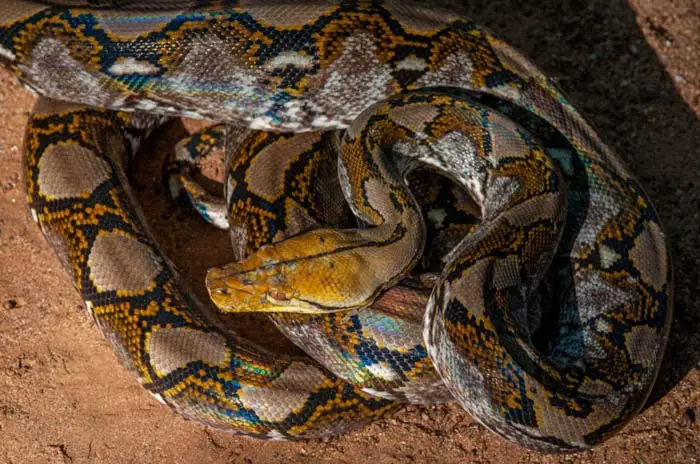
Maintain a 12/12 light/dark photocycle for your Retic. This will help it perform natural functions and reduce stress. Having a light on or no light all the time will impact your snake’s health.
Having the enclosure exposed to natural light during the day is a good idea. However, avoid direct sunlight as this will overheat the enclosure and kill your Retic.
Humidity
Retics need a humidity level of between 50% and 70%. They will need the higher end of the range to shed effectively.
Carefully monitor the enclosure’s humidity levels with a hygrometer. If the humidity is too low, your Retic will have trouble shedding and if it is too high then your Retic can develop respiratory problems.
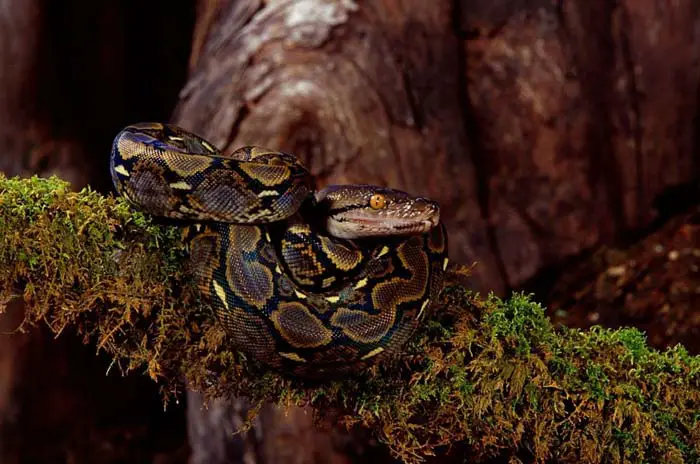
The water bowl will provide a large amount of humidity that the enclosure needs. However, misting once a day will help maintain the levels and prevent unnecessary drops in humidity. You can do it using automatic fogger like REPTI ZOO Reptile Mister.
If you have natural vegetation in the enclosure make sure that it is not pushing the humidity levels up into unhealthy regions.
Diet
Your Retic needs access to a healthy supply of fresh water daily.
We suggest a heavy-based water bowl/container that is easy to clean, completely leak-proof, large enough for your snake to soak in, deep enough that the water won’t slop over the side, and won’t tip over.
If the water slops over the side or the entire container tips over it will raise the humidity levels to a fatal level.
We suggest placing the water bowl on the cooler side of the enclosure.
Food:
Food is the defining factor in Reticulated Python size. However, there is a minimum you need to feed your Retic for it to be healthy.
- We suggest one prey item of equal girth to the thickest part of the snake once every 14 days.
- These prey items can include rodents, birds, rabbits, or young pigs.
- If you are aiming at maximum growth of your Retic then feed your snake two prey items of equal girth to the thickest part of the snake once every 14 days.
- Feed your snake in its enclosure.
We always suggest frozen/thawed prey (F/T) and never live prey. The live prey item can attack and damage your snake, it can carry parasites, and there is the additional cost of maintaining live prey in suitable conditions.
When it comes to feeding time, put the prey item in a bucket of hot water and let it sit until it is completely thawed. Feeding your snake partially frozen prey is fatal.
Do not jerk the prey item or your hand back when the snake strikes at the prey item, this can prompt an aggressive response. If you are worried about getting bitten then wear gloves and/or a coat to protect yourself.
Reticulated Pythons are happy eaters and will eat whenever you feed them so keep to a strict regimen to avoid overfeeding.
Always offer the food far away from your face and avoid the urge to lean in to check out what is happening. A Retic bite to the face can be disfiguring at best and fatal at worst.
Never handle your Retic 24 hours prior to, during, or for 48 hours after feeding. This will cause your snake to regurgitate its food due to stress.
Your Retic may or may not go off feed during shed, every animal is different.
Handling
Handling is another reason we put Reticulated Pythons on our Expert Level list. They are long and heavy snakes. They can easily crush you to death.

You need to be able to read your Retic and judge its behavior to know when you are in danger and when handling is okay.
We always suggest having another person present when handling a Reticulated Python over 10 feet. They will help keep you safe by preventing the snake from coiling around you and call for help if the constrictor decides you are its next meal.
However, having said all of that, handling your Retic can be an incredibly rewarding experience because they are heavy-bodied snakes which makes for a much more substantial handling experience.
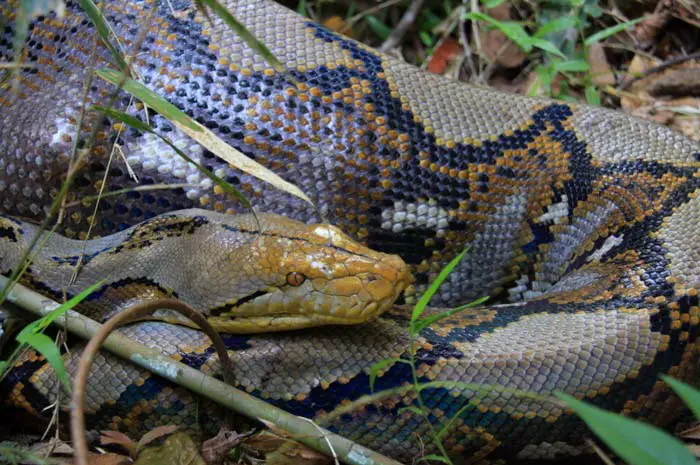
Your snake will inevitably think you are feeding it when you approach the enclosure. Show that there is no prey item and wait for the snake to calm down before attempting to pick it up.
Another way you could do this is by hook training it. Feed the snake by offering the prey item with your hand and when you want to handle it use a hook to make it aware.
This means that the snake will associate the hook with handling and not food.
Always support your snake’s body appropriately and keep its head pointed away from anyone’s face and neck.
Potential Health Issues
- Too high humidity will cause respiratory problems and can lead to scale and mouth rot. Seek a vet’s help and adjust humidity levels.
- Incorrect enclosure care and poor sanitary practices between handling reptiles can introduce a mite infestation. A full sanitization of the enclosure will be necessary.
- Overfeeding is a real problem. Fat snakes are not funny snakes, obesity puts a strain on the heart and liver and is fatal.
- A stuck shed can be common. The Reticulated Python’s skin is very thin so they do not shed all in one go and stuck shed will cause problems. This usually means your humidity is too low. Give your snake a good soak and adjust your humidity levels.
Breeding
Sexual maturity is judged by size more than age. Males generally reach sexual maturity at 18 months or 10 feet, females reach maturity at 3 years or 14 feet.
Reticulated Pythons breed at the beginning of the rainy season in the wild. To mimic this (match it up to your country’s winter months.)
You should brumate your Retics very moderately.
Towards the end of your winter months (about one month left) slowly lower the overall temperature of the enclosure so that the cool side is sitting at 65-70°F. Reduce the photocycle to 10/12 or even 8/14 light/dark.
There is a good chance that your Retic will go off food during this time.
At the end of the final winter month slowly start raising the temperature back to normal and reset the photocycle. You can slightly increase the humidity as well.
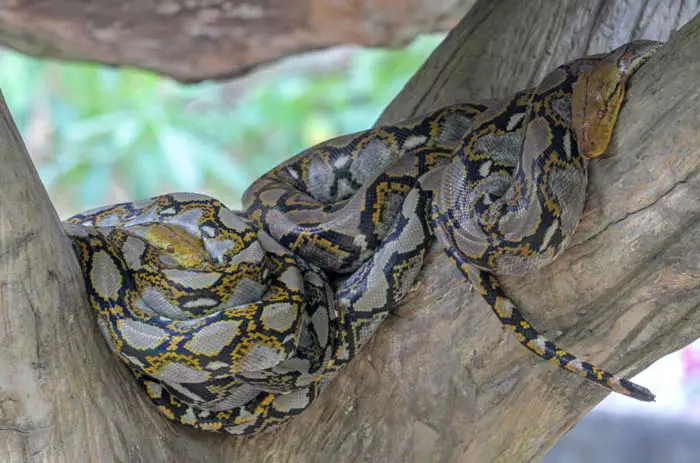
Now is the time to introduce your male to the female’s enclosure. Females can be cannibalistic so watch their behavior closely.
Remove the male once a week to feed them smaller prey items separately. You can either cycle the males or reintroduce the male a couple of times. When you think the female is gravid (pregnant) remove the male permanently.
The female will do a pre-lay shed. At this time put a nesting box in her enclosure that is large enough for her to coil up in. Line the box with some sphagnum moss to maintain humidity for the eggs.
Galápagos Terrarium Sphagnum Moss
She can lay up to 60 eggs but usually, 20-40 eggs will be produced per clutch. Generally, the smaller the snake, the smaller the clutch. Do not breed your snakes below their sexual maturity size.
The eggs will take between 60 and 80 days to hatch. The female does a great job of incubating the eggs by coiling around them and shivering her body to generate warmth. She will not take feed during this time so just make sure the enclosure stays in a good state.
Mama snake’s job is done and the baby Retics are now fair game. When the eggs hatch, remove them to their enclosures (a Rubbermaid type tub is sufficient for now.)
Females can have a clutch per year.
There are cases of parthenogenesis on record for Reticulated Pythons. Very basically, this means that the female will produce a ‘self-fertilized’ egg that is an exact DNA copy of herself.
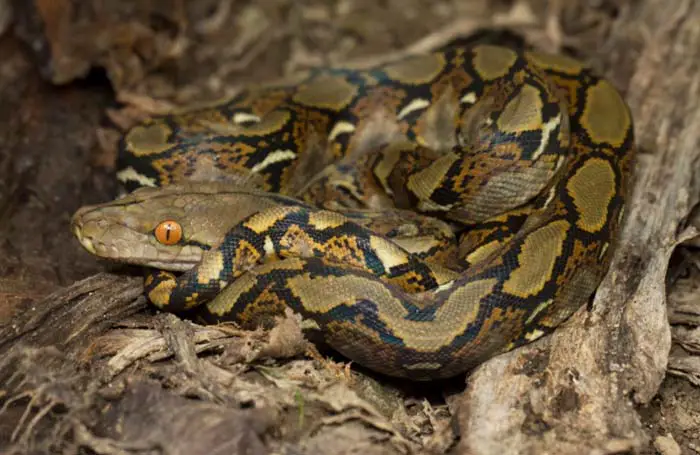
Due to their large clutch sizes, there is a question of whether breeding is the best idea if you do not have buyers lined up. You could be sitting with 60 new babies that will require their own huge enclosures very soon.
Conclusion
Reticulated Pythons are phenomenal snakes to observe and study. They need specialized care due to their size and the danger factor. However, for an Expert Level snake owner they can make great pets.
Before purchasing your Retic, do your research and make sure you are ready for the long-haul, both in terms of time and finances.
If you are equipped to care for them correctly, they will be a long-term fixture in your life. We wish you every success and ‘herp’ you have a fruitful and bite-free future with your Reticulated Python.
Related:

